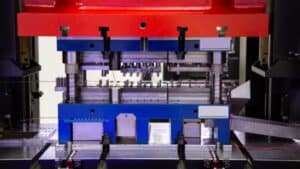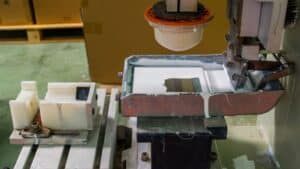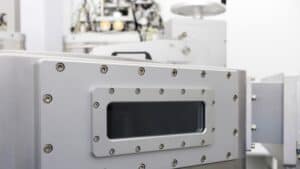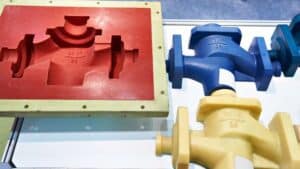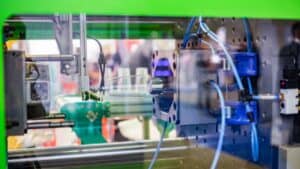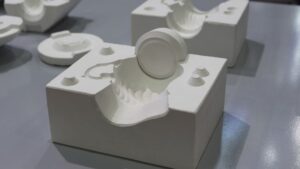Polypropylene injection molding is a highly efficient and versatile manufacturing process used to produce a wide range of plastic parts and products. Leveraging the unique properties of polypropylene (PP), this process enables the creation of intricate, durable, and cost-effective components suitable for various industries.
What is Polypropylene?
Polypropylene plastic is a popular plastic injection molding material that is used in many applications.
One strength of polypropylene is its chemical resistance. It stands up well to various acids and bases. This makes it an excellent choice for containers and packaging.
There are two main types of polypropylene: homopolymer and copolymer. Homopolymer polypropylene offers a great balance in terms of mechanical properties and stability. Copolymer polypropylene, on the other hand, has better impact resistance, making it useful for tough environments.
Here is a table for you to have a quick check of the different types of polypropylene:
| Type | Description | Properties | Applications |
| Homopolymer PP (PP-H) | Made from only propylene monomers, PP-H is the most common type of polypropylene. | – High rigidity and tensile strength – Good chemical resistance – Lower impact resistance | Rigid containers, automotive parts, textiles, laboratory equipment |
| Random Copolymer PP (PP-R) | Incorporates ethylene units, resulting in random distribution along the polymer chain. | – Improved clarity and impact resistance compared to PP-H<br> – Better low-temperature performance | Transparent containers, piping systems, automotive parts |
| Impact Copolymer PP (PP-I) | Contains a higher proportion of ethylene, usually at one end of the polymer chain. | – Enhanced impact resistance, even at low temperatures – Higher toughness and flexibility | Living hinges, automotive components, consumer goods |
| Block Copolymer PP (PP-B) | Contains blocks of ethylene and propylene, providing a combination of properties. | – Superior toughness – Better stress crack resistance – Enhanced flexibility | High-stress applications, flexible packaging, medical devices |
| Metallocene PP | Produced using metallocene catalysts, allowing precise control over polymer structure. | – Exceptional clarity and color consistency – Precise molecular weight distribution | High-precision applications, packaging, medical devices |
The versatility of polypropylene means it’s used in everything from the automotive industry to household goods and consumer products. Its recyclable nature is a bonus for environmentally conscious manufacturers.
Polypropylene Material Properties in Injection Molding
| Property Category | Property | Value/Description |
| Physical | Density | 0.895 – 0.93 g/cm³ |
| Molecular Weight | Relatively high | |
| Surface Finish | Smooth | |
| Transparency | Naturally opaque, can be made transparent | |
| Mechanical | Tensile Strength | 4,800 psi (33 MPa) |
| Tensile Modulus | 195,000 psi (1.34 GPa) | |
| Flexural Strength | 7,000 psi (48 MPa) | |
| Flexural Modulus | 180,000 psi (1.24 GPa) | |
| Hardness | 92 Rockwell R | |
| Impact Strength | Good, lower than polyethylene | |
| Elasticity | Highly elastic | |
| Thermal | Melting Point (Homopolymer) | 160 – 165°C |
| Melting Point (Copolymer) | 135 – 159°C | |
| Softening Temperature | Around 130°C | |
| Maximum Operating Temperature | 180°F (82.2°C) | |
| Thermal Conductivity | Low | |
| Thermal Expansion | Low | |
| Chemical | Chemical Resistance | Excellent to many chemicals, acids, solvents |
| Water Absorption | < 0.01% in 24 hours | |
| Moisture Absorption | Low | |
| Resistance to Acids | Good | |
| Resistance to Alkalis | Good | |
| Resistance to Organic Solvents | Good | |
| Susceptible to | Oxidizing acids, chlorinated hydrocarbons, aromatic solvents | |
| Electrical | Electrical Insulation | Good |
What are the Advantages and Disadvantages of Polypropylene?
Mechanical Properties
Advantages:
- High Tensile Strength and Flexibility: Polypropylene exhibits excellent tensile strength, allowing it to withstand significant stress without breaking. Its inherent flexibility makes it suitable for applications that require some degree of bending without cracking.
- Excellent Impact Resistance: PP is resistant to moisture, making it ideal for products that are subject to sudden forces or shocks.
- Good Fatigue Resistance: The material can endure repeated loading and unloading cycles, maintaining its structural integrity over time.
Disadvantages:
- Lower Rigidity: Compared to plastics like polycarbonate or ABS, polypropylene is less rigid. This can be a limitation in applications where high stiffness is essential.
- Limited High-Temperature Performance: PP can deform under prolonged exposure to high temperatures, restricting its use in applications requiring thermal stability beyond its heat deflection temperature.
Chemical Resistance
Advantages:
- Wide Chemical Resistance: Polypropylene is highly resistant to a variety of chemicals, including acids, bases, and solvents. This makes it ideal for containers, piping systems, and chemical processing equipment.
- Low Moisture Absorption: PP absorbs minimal moisture, ensuring dimensional stability and preventing degradation in humid environments.
Disadvantages:
- Susceptibility to Certain Solvents and Oils: While PP resists many chemicals, it can degrade when exposed to specific solvents, oils, and hydrocarbons, limiting its use in certain industrial applications.
Thermal Properties
Advantages:
- High Melting Point: With a melting temperature typically between 160°C to 170°C, polypropylene can withstand various processing conditions, ensuring stability during injection molding.
- Good Heat Deflection Temperature (HDT): PP maintains its shape and structural integrity under moderate thermal stress, suitable for products exposed to heat.
Disadvantages:
- Limited High-Temperature Performance: PP begins to soften at temperatures above its HDT, making it unsuitable for applications requiring resistance to extreme heat.
- Brittleness in Cold Environments: Without the addition of impact modifiers, polypropylene can become brittle and prone to cracking in low-temperature conditions.
Electrical Properties
Advantages:
- Excellent Electrical Insulator: Polypropylene’s high electrical resistivity makes it an ideal material for electrical and electronic components, such as connectors, insulating housings, and capacitors.
- High Resistivity: Ensures minimal energy loss and efficient performance in electrical applications.
Disadvantages:
- UV Degradation: Prolonged exposure to ultraviolet (UV) light can degrade polypropylene, leading to discoloration and loss of mechanical properties unless UV stabilizers are incorporated.
Processing and Manufacturing
Advantages:
- Excellent Flow Characteristics: PP flows easily into mold cavities, allowing for the production of intricate and detailed parts with high precision.
- Ease of Processing: The material can be processed with minimal cycle times, enhancing production efficiency and reducing costs.
- Highly Recyclable: Polypropylene can be recycled multiple times without significant loss of properties, promoting sustainable manufacturing practices.
Disadvantages:
- Need for Precise Control: Achieving high-quality parts requires meticulous control of processing parameters such as temperature, pressure, and cooling rates to prevent defects like warping, sink marks, or flow lines.
Cost and Availability
Advantages:
- Relatively Low Cost: Polypropylene is one of the more cost-effective thermoplastics, making it an economical choice for large-scale production and cost-sensitive applications.
- Wide Availability: The material is readily available in various grades and forms, ensuring ease of sourcing for manufacturers.
Disadvantages:
- Increased Cost for Specialized Grades: High-performance or specialized polypropylene grades with enhanced properties (e.g., flame retardant, high clarity) may incur higher costs, impacting overall production budgets.
Design Considerations for Injection Molding Polypropylene Molds
Effective mold design is fundamental to the success of polypropylene (PP) injection molding. The intricate interplay between mold geometry, material properties, and processing parameters dictates the quality, consistency, and efficiency of the final product.
Below are the key design considerations that manufacturers must address when designing molds for polypropylene injection molding.
Mold Material Selection
- Tool Steel: Commonly used due to its hardness, wear resistance, and ability to maintain sharp features.
- H13: Excellent for high-temperature applications and offers good toughness.
- P20: Ideal for general-purpose molding with sufficient durability.
- S7: Suitable for shock-resistant molds with intricate details.
- Aluminum: Used for prototyping or low-volume production due to its lower cost and ease of machining. However, it is less durable than tool steel and not recommended for high-volume runs.
Gate Design
The gate is the entry point through which molten polypropylene flows into the mold cavity. Proper gate design is essential to ensure uniform filling, reduce defects, and facilitate easy ejection.
- Types of Gates:
- Edge Gate: Simple and economical, suitable for thin-walled parts. However, it can leave a noticeable mark on the part.
- Submarine Gate: Positioned below the surface, it minimizes visible gate marks and is ideal for aesthetic parts.
- Hot Runner Gate: Maintains the melt temperature within the runner system, reducing material waste and cycle times. This is beneficial for high-volume production.
- Fan Gate: Distributes the molten PP evenly across the cavity, minimizing weld lines and ensuring uniform part quality.
Cooling System Design
Efficient cooling is vital for reducing cycle times, minimizing warping, and ensuring uniform part quality.
- Cooling Channel Layout:
- Straight vs. Spiral Channels: Straight channels are easier to machine and clean, while spiral channels provide uniform cooling.
- Tree Cooling vs. Ring Cooling: Tree cooling offers targeted cooling for complex geometries, whereas ring cooling is suitable for simpler parts.
- Coolant Type and Temperature:
- Type: Typically, water-based coolants are used due to their high thermal capacity and cost-effectiveness.
- Temperature: Maintaining a consistent coolant temperature (usually between 20°C to 50°C) ensures stable cooling rates and minimizes thermal gradients.
Draft Angles
Incorporating adequate draft angles facilitates the ejection of polypropylene parts from the mold, reducing the risk of part deformation or damage.
- Standard Draft Angle: Typically ranges from 1° to 3°, depending on the complexity and surface finish requirements of the part.
- Factors Influencing Draft Angle:
- Wall Thickness: Thicker walls may require larger draft angles to compensate for higher ejection forces.
- Surface Texture: Smooth or intricate textures may necessitate steeper draft angles to prevent sticking or tearing.
Gate Location and Number
Determining the optimal number and placement of gates is essential for ensuring efficient filling, minimizing cycle times, and reducing material waste.
- Single vs. Multiple Gates:
- Single Gate: Simpler and more cost-effective but may lead to uneven filling in complex or large parts.
- Multiple Gates: Ensure balanced filling and reduce cycle times but increase mold complexity and potential for material waste.
- Gate Location:
- Central Placement: Promotes uniform filling and minimizes weld lines.
- Peripheral Placement: Suitable for parts with uniform thickness and simple geometries.
Core and Cavity Design
The design of cores and cavities directly influences the shape, detail, and overall quality of the molded polypropylene parts.
- Complex Geometries: Utilize advanced machining techniques and mold design software to create molds capable of producing intricate and detailed features.
- Undercuts and Slides: Incorporate necessary mold slides and lifters to accommodate undercuts and complex part geometries without causing part damage or mold wear.
- Tolerance Control: Ensure tight tolerances in mold design to achieve dimensional accuracy and consistency across production runs.
Mold Design in Polypropylene Injection Molding with Moldie
To enhance the effectiveness of mold design for polypropylene injection molding, consider cooperating with Moldie to accomplish the following best practices:
- Collaborative Design Process:
- Involve mold designers, engineers, and production teams early in the design process to ensure that all aspects of part functionality, aesthetics, and manufacturability are addressed.
- Use of Advanced Simulation Tools:
- Leverage simulation software to predict and mitigate potential molding issues, optimizing mold design for efficiency and quality.
- Implementing Quality Control Measures:
- Incorporate features that facilitate inspection and quality control, such as integrated measuring points or easy access to inspection tools.
- Sustainability Considerations:
- Design molds for minimal material waste, efficient cooling, and easy recyclability to support sustainable manufacturing practices.
- Continuous Improvement:
- Regularly review and update mold designs based on feedback from production runs, part performance data, and advancements in mold-making technologies.
What is the Polypropylene Injection Molding Process?
To get the best results from polypropylene injection molding, it is crucial to manage process factors like temperature and pressure. Controlling these elements can help reduce defects and enhance the quality of the final product.
Material Selection and Preparation
Polypropylene is available in various grades, and it is hygroscopic, meaning it can absorb moisture from the environment. Excess moisture can lead to hydrolysis during melting, resulting in poor mechanical properties and surface defects like splay or silver streaks. Therefore, it is essential to dry PP pellets before processing:
- Drying Temperature: Typically between 90°C to 120°C.
- Drying Time: Approximately 4 to 6 hours, depending on the moisture content and pellet size.
- Drying Equipment: Utilize a dedicated drying hopper or an online drying system integrated with the injection molding machine.
Heating and Melting
Dry polypropylene pellets are fed into the injection molding machine’s hopper, where they are conveyed toward the heated barrel by the screw mechanism.
As the pellets move along the heated barrel, they undergo melting due to the applied thermal energy combined with mechanical shearing from the screw’s rotation.
- Heating Zones: The barrel typically has multiple heating zones, each controlled individually to achieve a uniform melt temperature.
- Melting Temperature: Maintain a consistent melt temperature, usually between 220°C to 260°C, depending on the specific PP grade and part requirements.
Injection Phase
Once the PP is fully melted and homogenized, the screw rapidly injects the molten material into the mold cavity.
- Injection Pressure: High enough to ensure complete mold filling without causing flash or over-packing. Typically ranges between 800 to 1,200 bar, but this can vary based on part complexity and wall thickness.
- Injection Speed: Optimized to prevent defects such as jetting or flow lines. Faster injection speeds are beneficial for thin-walled parts, while slower speeds may be necessary for thicker sections.
The molten PP flows into the mold cavity, conforming to the intricate details and geometry of the mold. Proper flow is essential to avoid defects like short shots, sink marks, or incomplete filling.After the initial injection, additional pressure (pack pressure) is applied to compensate for material shrinkage as the polymer cools.
- Pack Time: Duration varies based on part size and material characteristics.
- Pack Pressure: Carefully controlled to ensure dimensional accuracy and surface finish.
Cooling Phase
Once the mold is filled and packed, the molten polypropylene begins to cool and solidify within the mold cavity.
- Cooling Channels: An efficient cooling system with strategically placed channels ensures uniform temperature distribution, minimizing warping and reducing cycle times.
- Cooling Time: Depending on part thickness and mold design, cooling times typically range from 10 to 30 seconds.
Maintaining optimal mold temperatures (usually between 20°C to 80°C).
Mold Opening and Part Ejection
After the polypropylene has sufficiently cooled and solidified, the mold opens to release the newly formed part.
Ejector pins or plates push the part out of the mold cavity. Proper ejection design prevents part deformation or damage during removal.
- Ejector Pin Placement: Strategically positioned to avoid leaving marks or defects on the part surface.
- Ejection Pressure: Controlled to ensure smooth and defect-free ejection.
Applications of Polypropylene Mold Parts
Consumer and Industrial Goods
You interact with polypropylene through many everyday items. It’s commonly used in packaging, like food containers, bottles, and caps, because it keeps your items fresh and secure. For household products, polypropylene can be found in items like reusable storage bins, plastic furniture, and kitchenware. It stands up well to wear and tear, making it fitting for these purposes.
In the industrial world, polypropylene is used in ropes, textiles, and even electronics components. It’s chosen for its durability and ability to withstand harsh conditions. In various settings, polypropylene offers a mix of strength and resilience.
Medical and Automotive Components
In the medical field, polypropylene is valued for being hypoallergenic and easily sanitized. It’s common in disposable syringes, medical containers, and even surgical tools. Its resistance to bacteria and ease of sterilization are key for health settings.
When it comes to cars, polypropylene is used in bumpers, dashboards, and interior trim. It’s lightweight, helping improve fuel efficiency and performance. Its impact resistance means it can protect you in minor collisions, all while offering an attractive finish to the vehicle’s interior.
Frequently Asked Questions
How does polypropylene injection molding compare in cost to other plastics?
Polypropylene is often more cost-effective than other plastics, making it a budget-friendly option for large-scale production. Despite its lower price, it doesn’t compromise on quality, offering a good balance between cost and performance.
What are the differences between injection molding of polypropylene and polyurethane?
Polypropylene is more rigid, while polyurethane is flexible and elastic. These differences affect their uses, with polypropylene favored for stiff products and polyurethane for items that need to stretch or bend. The molding processes also differ slightly due to these material properties.

